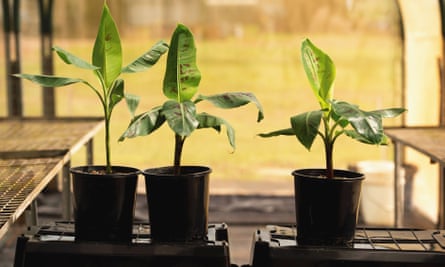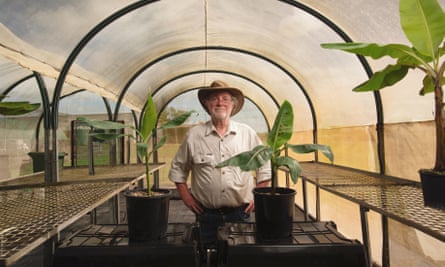Scientists have submitted Australia’s first genetically modified fruit – a Cavendish banana – to regulators for approval, saying it has been engineered to withstand a deadly fungus that poses a threat to banana growers worldwide.
The banana, known as QCAV-4, has been genetically modified to resist a fungus known as Panama disease tropical race 4 (TR4), which is threatening the multibillion-dollar Cavendish industry globally.
If approved, the banana would become Australia’s first GM fruit to be approved for cultivation and consumption, as well as the first GM banana to be approved worldwide.
Prof James Dale of the Queensland University of Technology, who led QCAV-4’s development, said the GM variety offered a safety net for growers in the event that the Australian industry was wiped out by TR4.
The research team is not planning on immediately releasing the banana for commercial production or consumption if approved.
There are between 300 and 1,000 varieties of banana globally, Dale estimates, but the Cavendish banana accounts for about half of commercial growing worldwide. “It has some disease resistance, it’s high yielding, it tastes pretty good and it travels well,” Dale said.
Cavendish bananas increased in popularity after an outbreak of Panama disease – the strain TR1 – wiped out plantations of the Gros Michel banana, which until the 1950s was the main commercial variety internationally.
In the 1990s a related fungus that affects Cavendish bananas, Panama TR4, was discovered in south-east Asia. It has has since spread to China, India and major banana-growing countries.

“Eighty-five per cent of the world’s export bananas come from south and central America, and the other 15% come from the Philippines,” Dale said. “The Philippines is already dramatically affected by TR4.
“Once it got to Colombia, and then Peru and now Venezuela, that’s when the big exporters suddenly realised that this is really very serious.”
In Australia Panama TR4 was first discovered in the Northern Territory, where it was gradually wiping out the industry, said Leon Collins, chair of the Australian Banana Growers’ Council.
“On the east coast, we only have it in the Tully River valley at the moment. We’ve confined it to that so far because of good biosecurity, and also the big effort that the growers have made.”
The fungus “attacks the root of the plant and kills it slowly”, Collins said. “It virtually dehydrates the plant and it wilts.”
Collins described the genetically modified QCAV-4 as “another string in the bow … that we can use. One day [we] may not have an industry here growing with normal bananas.”
QCAV-4, the result of 20 years’ work, was developed by taking a resistance gene from a wild banana that is immune to TR4 and inserting it into the Cavendish.
after newsletter promotion
Using six transgenic varieties of the banana, Dale and his colleagues began field trials south-east of Darwin in 2012, with good results.
“We did a much, much bigger field trial that we planted in 2018, and that’s still going,” Dale said. One variety, now called QCAV-4, showed a 2% infection rate after four years, compared with 95% and 75% infection rates in two lots of regular Cavendish plants.
“If the disease gets going [in Australia] like it has in the Philippines … we’ve got this banana in the back pocket and we’ll be able to pull it out.”

Cavendish bananas, including the QCAV-4, are incapable of sexual reproduction – every plant propagated is an identical clone. This means that “the genes aren’t going to flow to any other plant”, Dale said.
A spokesperson for the Office of the Gene Technology Regulator said: “This is a significant step, but it is the first in a series of steps.
“The gene technology regulator will carefully examine any risks to people and the environment posed by the commercial cultivation of the GM banana plants.
“The regulator will only issue a licence authorising the cultivation of the GM banana if satisfied that any risks can be effectively managed.”
The spokesperson said two rounds of stakeholder consultation would be required, with public consultation expected to occur in August.
Food Standards Australia New Zealand is assessing the banana’s suitability for commercial sale and consumption. Its chief executive, Dr Sandra Cuthbert, said: “Consumers can have trust and confidence in FSANZ’s independent scientific assessment. We develop world-leading standards and our experts have a strong track record of assessing the safety of novel foods.
“We will invite public submissions on any proposed changes to the Australia New Zealand food standards code resulting from our assessment of this application.”










